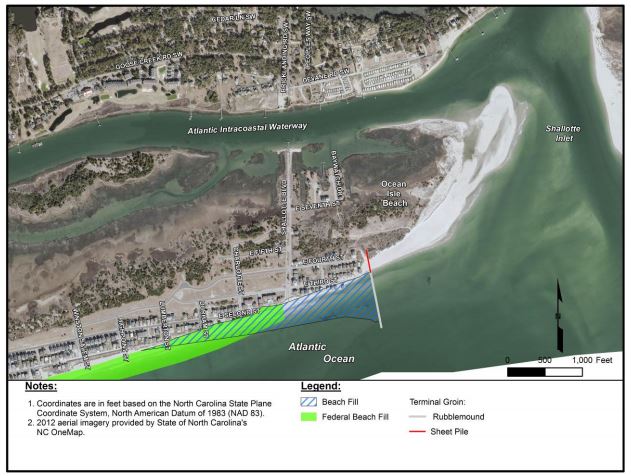
A recent court ruling now opens the way for Ocean Isle Beach to build a terminal groin at the east end of its ocean shoreline and plans are underway to kick off construction later this year.
A three-judge panel in the U.S. Court of Appeals for the Fourth Circuit affirmed a lower court’s decision that the U.S. Army Corps of Engineers fairly considered the alternatives included in an environmental impact statement examining the proposed project. The judges rendered their opinion March 26.
Supporter Spotlight
Their decision ends a yearslong fight stretching back to August 2017, when the National Audubon Society filed a lawsuit challenging the Corps’ approval of the proposed project. The town was included in the lawsuit shortly after the suit was initially filed.
Ocean Isle Mayor Debbie Smith said in a telephone interview last week that she expected town commissioners to approve engineering contracts in the coming days.
She said the town will have updated information on the present condition of the shoreline, including surveys and beach profiles, before soliciting bids.
“All that has certainly changed since our original bid opening,” she said.
Smith said the town is aiming to start construction on the project in November.
Supporter Spotlight
Ocean Isle Beach had both a North Carolina Division of Coastal Management-issued Coastal Area Management Act, or CAMA, major permit, and the necessary federally approved permit by the end of February 2017.
Those permits remain valid.
The Department of the Army’s authorization is effective through Dec. 31, 2027.
As long as the town adheres to the permit conditions and does not request to modify the permit, the town will not have to reapply for federal authorization, Emily Winget, a public affairs specialist with the Corps’ Wilmington District, said in an email.
The town’s CAMA major permit will expire Dec. 31. A spokesperson with the Division of Coastal Management said the town will not have to apply for a new permit or provide additional information to the state unless the town changes the project from what is currently permitted.
The town had advertised for bids on the project, which will include construction of a 750-foot-long terminal groin of large armor rock, before the lawsuit was filed in U.S. District Court in Wilmington.
The lawsuit claimed that the Corps had approved the multi-million-dollar project without fairly considering other alternatives that would be cheaper for the town’s taxpayers, adequately protect vulnerable properties and maintain wildlife habitat at the east end of the barrier island in Brunswick County.
The Southern Environmental Law Center, which filed the suit on behalf of Audubon, alleged that the Corps failed to fairly evaluate project alternatives in the EIS and secondary effects of the alternatives presented in the study. The lawsuit also alleged that the alternative selected by the engineering firm hired by the town to complete the EIS and approved by the Corps was not the least environmentally damaging alternative and that the Corps did not independently evaluate environmental information submitted by Coastal Planning & Engineering of North Carolina Inc.
Geoff Gisler, senior attorney with the law center’s Chapel Hill office, said the appellate court’s decision is disappointing.
“I think one of the things that is important as we go forward is that part of the reason the decision came out the way it did is that the court deferred to the Corps that there would not be harmful effects on the eastern end of the island,” he said. “If the town chooses to go forward with the project we’ll be watching to make sure that is the case.”
The terminal groin, a wall-like structure built perpendicular to the shore, would be designed to mitigate erosion along 3,500 feet of the town’s oceanfront shoreline west of Shallotte Inlet.
About 264,000 cubic yards of sand dredged from that inlet will be placed behind the structure once it is complete.
A wall of sandbags 15 feet tall and at least 1,500 feet long stretches along the east-end shore to protect private properties, roads and public utilities from erosion, Smith said.
“And I’m ready for them to be covered up and never seen again,” she said. “The town of Ocean Isle has worked diligently for a lot of years to try to make this a reality. They’re proven structures when properly installed.”
Those efforts began more than 10 years ago in a pursuit to get North Carolina legislators to ditch a decades-long ban on terminal groins, hardened erosion control structures that, opponents argue, may cause increased erosion down the beach from where they are constructed.
The North Carolina General Assembly in 2011 passed Senate Bill 110, which repealed a 30-year-old ban on hardened structures and allowed four test terminal groins to be built on the coast. That number was later raised to six.
Since then, only one town – the Village of Bald Head Island in Brunswick County – has built a terminal groin.
North Topsail Beach in Onslow County is in the process of having an environmental study prepared for a proposed terminal groin at New River Inlet.








